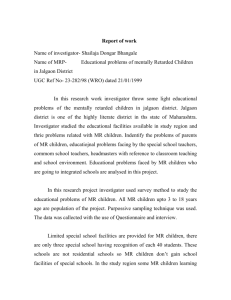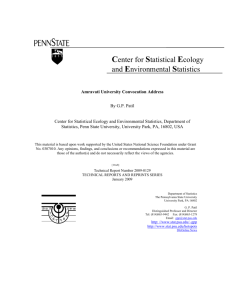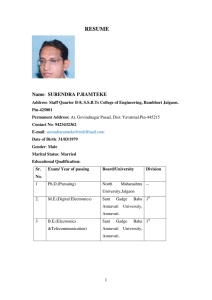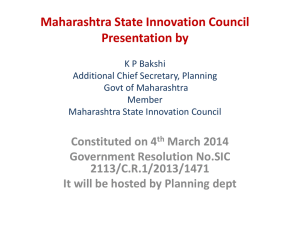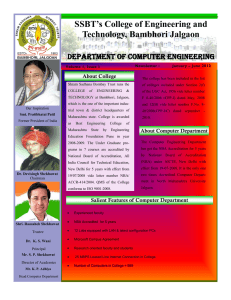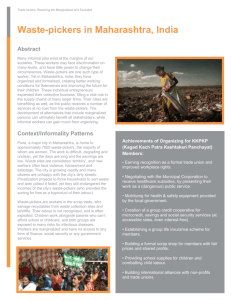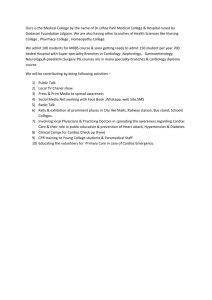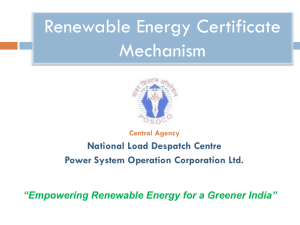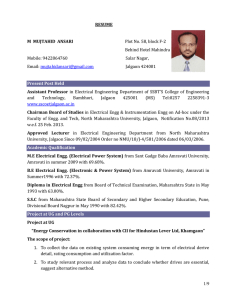Augmentation of River water use through linkage of Geohydrological
advertisement
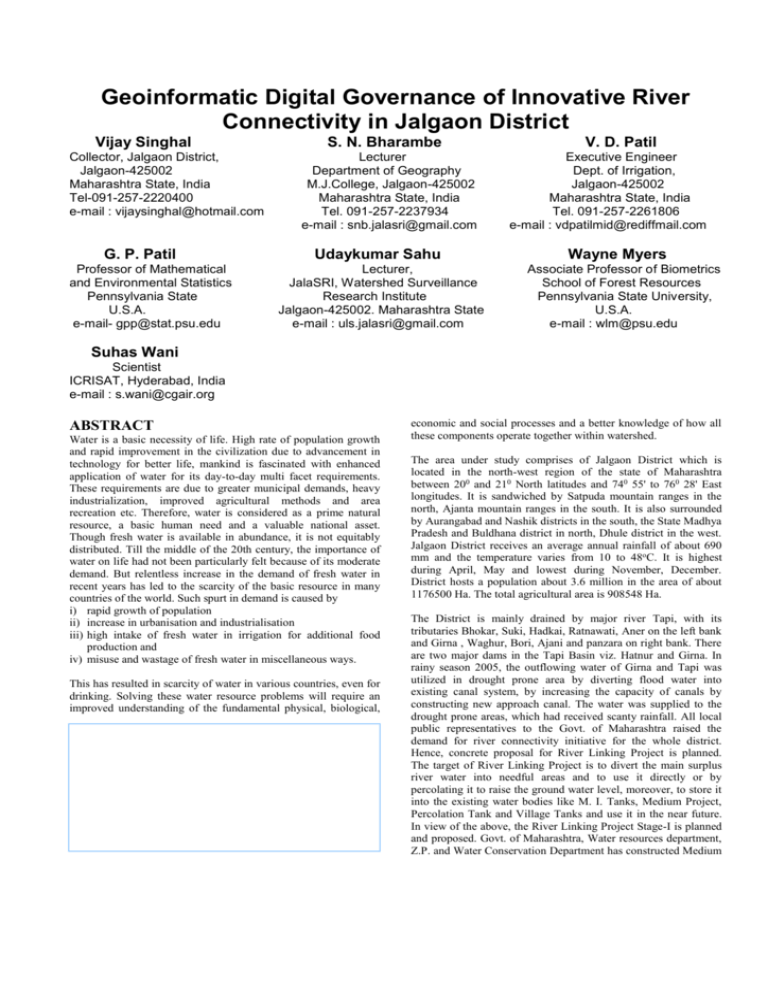
Geoinformatic Digital Governance of Innovative River Connectivity in Jalgaon District Vijay Singhal Collector, Jalgaon District, Jalgaon-425002 Maharashtra State, India Tel-091-257-2220400 e-mail : vijaysinghal@hotmail.com G. P. Patil Professor of Mathematical and Environmental Statistics Pennsylvania State U.S.A. e-mail- gpp@stat.psu.edu S. N. Bharambe Lecturer Department of Geography M.J.College, Jalgaon-425002 Maharashtra State, India Tel. 091-257-2237934 e-mail : snb.jalasri@gmail.com Udaykumar Sahu Lecturer, JalaSRI, Watershed Surveillance Research Institute Jalgaon-425002. Maharashtra State e-mail : uls.jalasri@gmail.com V. D. Patil Executive Engineer Dept. of Irrigation, Jalgaon-425002 Maharashtra State, India Tel. 091-257-2261806 e-mail : vdpatilmid@rediffmail.com Wayne Myers Associate Professor of Biometrics School of Forest Resources Pennsylvania State University, U.S.A. e-mail : wlm@psu.edu Suhas Wani Scientist ICRISAT, Hyderabad, India e-mail : s.wani@cgair.org ABSTRACT Water is a basic necessity of life. High rate of population growth and rapid improvement in the civilization due to advancement in technology for better life, mankind is fascinated with enhanced application of water for its day-to-day multi facet requirements. These requirements are due to greater municipal demands, heavy industrialization, improved agricultural methods and area recreation etc. Therefore, water is considered as a prime natural resource, a basic human need and a valuable national asset. Though fresh water is available in abundance, it is not equitably distributed. Till the middle of the 20th century, the importance of water on life had not been particularly felt because of its moderate demand. But relentless increase in the demand of fresh water in recent years has led to the scarcity of the basic resource in many countries of the world. Such spurt in demand is caused by i) rapid growth of population ii) increase in urbanisation and industrialisation iii) high intake of fresh water in irrigation for additional food production and iv) misuse and wastage of fresh water in miscellaneous ways. This has resulted in scarcity of water in various countries, even for drinking. Solving these water resource problems will require an improved understanding of the fundamental physical, biological, economic and social processes and a better knowledge of how all these components operate together within watershed. The area under study comprises of Jalgaon District which is located in the north-west region of the state of Maharashtra between 200 and 210 North latitudes and 740 55' to 760 28' East longitudes. It is sandwiched by Satpuda mountain ranges in the north, Ajanta mountain ranges in the south. It is also surrounded by Aurangabad and Nashik districts in the south, the State Madhya Pradesh and Buldhana district in north, Dhule district in the west. Jalgaon District receives an average annual rainfall of about 690 mm and the temperature varies from 10 to 48oC. It is highest during April, May and lowest during November, December. District hosts a population about 3.6 million in the area of about 1176500 Ha. The total agricultural area is 908548 Ha. The District is mainly drained by major river Tapi, with its tributaries Bhokar, Suki, Hadkai, Ratnawati, Aner on the left bank and Girna , Waghur, Bori, Ajani and panzara on right bank. There are two major dams in the Tapi Basin viz. Hatnur and Girna. In rainy season 2005, the outflowing water of Girna and Tapi was utilized in drought prone area by diverting flood water into existing canal system, by increasing the capacity of canals by constructing new approach canal. The water was supplied to the drought prone areas, which had received scanty rainfall. All local public representatives to the Govt. of Maharashtra raised the demand for river connectivity initiative for the whole district. Hence, concrete proposal for River Linking Project is planned. The target of River Linking Project is to divert the main surplus river water into needful areas and to use it directly or by percolating it to raise the ground water level, moreover, to store it into the existing water bodies like M. I. Tanks, Medium Project, Percolation Tank and Village Tanks and use it in the near future. In view of the above, the River Linking Project Stage-I is planned and proposed. Govt. of Maharashtra, Water resources department, Z.P. and Water Conservation Department has constructed Medium Project, M.I.Tank, Percolation Tank, K.T.Weirs. However due to peculiar nature of Tapi river basin, and its geographical terrain locations and uneven spatial distribution of monsoon rain fall over the drainage and a noticed relative shift and periodicity in occurrence of rainfall within the sub-catchments, it is observed that large quantum of river flows during monsoon from some storages, in the form of flood has been left untapped thus resulting in many of the storage dams not attaining their planned conservative storage levels. It is therefore felt appropriate to undertake linking the conducive river sub valley storages within a large basins as the first step to implement the national river linking plan. GIS Information Systems are powerful analytical tools for improving public policies, programme management and service delivery. GIS Science has played a major role in the development of distributed hydrologic models and in improving our understanding of the spatial aspects of the distribution and movement of water in the spatial aspects of the distribution and movement of water in landscapes. GIS applications support every kind of governmental purpose at all levels of government for comprehensive planning and effective management of natural resources. With this view, JalaSRI-Institute of Watershed Surveillance and Research and Local Government with together recognised the need of river connectivity initiative in Jalgaon district as a thrust area and hence has decided to undertake collaborative studies concerning the issue. During the implementation some part of some villages at higher elevation have not been benefited by this initiative. However, a possibility of bringing them into the network can be assessed. Similarly the impact analysis of the river networking initiative in Jalgaon district needs to be addressed. In this process, the use of modern scientific tools and technologies such as GIS, Remote Sensing, sensor networks shall be made by JalaSRI and government authorities along with some active NGOs in the immediate future. GENERAL TERMS Management, Measurement, Documentation, Performance, Economics, Design, Security, Reliability, Verification KEYWORDS River connectivity, Geoinformatics, Geographical Information System, Remote Sensing, Socio-economic Impact, Cost-Benefit analysis, potential adverse impact, Sustainability INTRODUCTION The primary thrust of proposed work is as follows a) Proposed Link Clusters of River Connectivity initiative. b) Socio-Economic Aspects i) Provision of recharge canal ii) Provision linkages of valley storages c) Technical Details d) People participation e) Geographical statistics f) Conclusion and Remarks g) Future forecasting and predictions RESEARCH Remote Sensing and Geographical Information System is playing a rapidly increasing role in the field of water resource development. Remote Sensing provides multi-spectral, multitemporal and multi-sensor data of earth surface. One of the greatest advantages of using Remote Sensing data for water resource investigation and monitoring is its ability to generate information in spatial and temporal domain which is very crucial for successful analysis, prediction and validation. Since all governments are charged with matters within a geographic region, most government-associated data comes with a geographic component through which it can be organized, accessed and analysed in the GIS. Understanding where things happen is often a key to delivering government services. Integrating information from diverse sources based on where things happen or where things are, has proven to be a powerful way to plan and deliver public services more effectively and efficiently. This type of capabilities and data sources have an enormous impact beyond research and management because their potential influence on identification of locations and sites for river or canal connections. For this purpose activities are focussed on impact analysis of river connectivity initiative by using geo-informatics and modern tools like sensors networks. It deals with the study of 1. Geoinformatics of river linking induced ground water table rise and its amelioration. 2. Geoinformatics of flow measurement of rivers and canals for studying erosion. 3. Study of siltation problem to outline the direction of the river linking landscape setting. 4. Geoinformatics Hydrological modelling and landscape analysis 5. Application of GIS and RS in the analysis of Socio- economic impact assessment in the watersheds. 6. Promotion of the "Have not class" of local population in immediate vicinity of river network through micro-rural financing schemes. 7. Watershed stewardship program. 8. To undertake prototype work of Ajani or Jhiri watershed located in the region of river connectivity initiative integrated with local wisdom and practice. 9. Geoinformatics of Potential adverse impact of river linking initiative. ACKNOWLEDGEMENT Junior authors acknowledge the guidance of Dr. G. P. Patil, Pennsylvania State University; University Park; PA 16802-2112, Dr. Wayne Myers, Associate Professor of Biometrics School of Forest Resources, Pennsylvania State University, U.S.A., Khandesh College Education society, Jalgaon and Researchers Team of M. J. College for their support. REFERENCES 1. 2. 3. 4. 5. 6. 7. Annual Reports of Ground Water Survey and Development Agency, Maharashtra State, India Banerjee, Bireshwar, Sustainable Management of Water Resource, Transaction, IIG, Pune, Vol. 26(1), 2004 Bendale, N.G., Rao, A.G., Towards surveillance of watershed and its multidisciplinary impact: A Case Study, 2006 Census of India (2001) : Provisional Reports of Population of India, Registrar General and Census Commissioner, India, Govt. of India, New Delhi Gazetteer of Jalgaon District, Maharashtra State, India Jalgaon District River Linking Project, Jalgaon Irrigation Project Circle, Minor Irrigation Division, Jalgaon. Records of District Statistics Office, Jalgaon, Maharashtra State, India
